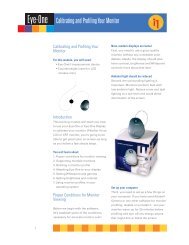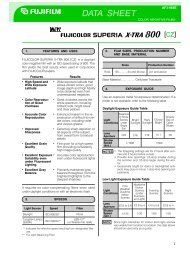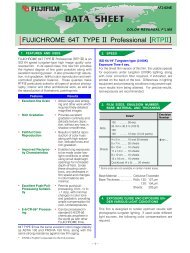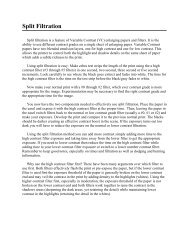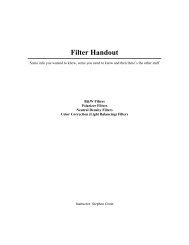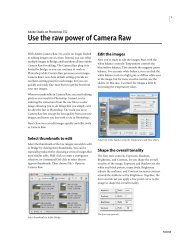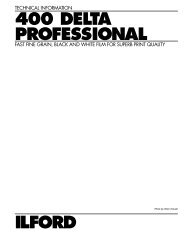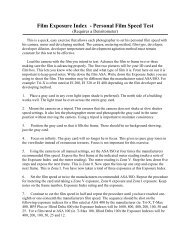FUJICHROME PROVIA 400F Professional [RHPIII] - Silverprint
FUJICHROME PROVIA 400F Professional [RHPIII] - Silverprint
FUJICHROME PROVIA 400F Professional [RHPIII] - Silverprint
You also want an ePaper? Increase the reach of your titles
YUMPU automatically turns print PDFs into web optimized ePapers that Google loves.
AF3-066E<br />
COLOR REVERSAL FILMS<br />
<strong>FUJICHROME</strong> <strong>PROVIA</strong> <strong>400F</strong> <strong>Professional</strong> [<strong>RHPIII</strong>]<br />
1. FEATURES AND USES<br />
<strong>FUJICHROME</strong> <strong>PROVIA</strong> <strong>400F</strong> <strong>Professional</strong> [RHP III] is a<br />
new-generation, high-image quality, daylight ISO 400<br />
color reversal film which boasts extremely fine grain –<br />
the best among films of its class – while providing the<br />
brilliant and faithful color reproduction and well-controlled<br />
gradation balance of ISO 100-class films. These<br />
qualities make this film an excellent choice for exacting<br />
professional use such as news, sports, model, fashion,<br />
landscape and product photography.<br />
Features<br />
• Ultra-fine Grain /<br />
High Resolution<br />
• Faithful and<br />
Brilliant Color<br />
Reproduction<br />
• Rich Tone<br />
Reproduction<br />
• Superior<br />
Reciprocity<br />
Characteristics<br />
• Excellent Push-/<br />
Pull-processing<br />
Performance<br />
• E-6/ CR-56*/C6R*<br />
Processing<br />
• Refined images ideal for<br />
large-size enlargements<br />
and other high-magnification<br />
applications, thanks to<br />
the finest grain among ISO<br />
400 color reversal films<br />
• ISO-100 film-level performance<br />
giving more faithful<br />
color reproduction and<br />
higher color saturation<br />
than any previous highspeed<br />
film<br />
• Smooth and continuous<br />
gradation linearity from the<br />
highlights to the shadows<br />
assuring delicate texture<br />
and rich tone reproduction<br />
• Minimal long-exposurerelated<br />
loss in film speed<br />
and changes in color as a<br />
result of improved silver<br />
halide emulsion<br />
• Push-/Pull-processing from<br />
– 1/2 stop (EI 280) up to<br />
+ 3 stops (EI 3200) with<br />
minimal changes in color<br />
and gradation, and even up<br />
to + 3 1/2 stops (EI 4800),<br />
depending on the subject<br />
• As with other<br />
<strong>FUJICHROME</strong> film, worldwide<br />
processing available<br />
using E-6/CR-56/C6R<br />
* CR-56 (Fujifilm) and C6R (Fuji/Hunt) are equivalent to E-6<br />
processing.<br />
– 1 –<br />
2. SPEED<br />
Light Source<br />
* Indicates the effective speed resulting from designated filter<br />
use.<br />
** Wratten Filter<br />
*** Fuji Light Balancing Filter<br />
3. FILM SIZES, EMULSION NUMBER,<br />
BASE MATERIAL AND THICKNESS<br />
Sizes *<br />
Emulsion<br />
Number<br />
135 ............. 36-exp.<br />
Rolls 35 mm × 30.5 m (100 ft) #201 –<br />
120 ............ 12-exp.<br />
............ 12-exp.(5-roll pack)<br />
* Some sizes are not available in certain markets.<br />
Base Material ............ Cellulose Triacetate<br />
Base Thickness ........ Rolls 135 : 127 µm<br />
120 : 98 µm<br />
4. EXPOSURE GUIDE FOR VARIOUS<br />
LIGHT CONDITIONS<br />
Use a meter for exposure determination. If a meter is<br />
not available, refer to the following table.<br />
Light<br />
Conditions<br />
Daylight<br />
Tungsten Lamps<br />
(3200K)<br />
Lens<br />
Aperture<br />
Shutter<br />
Speed (Sec.)<br />
Seashore or<br />
Snow Scenes Bright Hazy<br />
Under Bright Sunlight Sunlight<br />
Sun<br />
f/16<br />
1/1000<br />
Speed<br />
ISO 400<br />
ISO 125*<br />
f/11<br />
1/1000<br />
f/11<br />
1/500<br />
Filter<br />
None<br />
No.80A**<br />
(LBB-12***)<br />
Cloudy<br />
Bright<br />
f/11<br />
1/250<br />
Cloudy<br />
Day or<br />
Open<br />
Shade<br />
f/8<br />
1/250<br />
NOTES • The foregoing settings are for 2 hours after sunrise<br />
and 2 hours before sunset.<br />
• Provide a lens opening 1/2-stop smaller during the<br />
summer and 1/2-stop larger during the winter<br />
(except for snow scenes).<br />
• Excessively bright (or dark) or backlighted subjects<br />
may require plus (or minus) 1-stop lens opening<br />
adjustments.
FUJIFILM DATA SHEET • <strong>FUJICHROME</strong> <strong>PROVIA</strong> <strong>400F</strong> <strong>Professional</strong> [<strong>RHPIII</strong>]<br />
Daylight<br />
Under normal daylight conditions, color balancing filters<br />
are not necessary, but the following exposure conditions<br />
may require the indicated filters.<br />
Subject Conditions<br />
Open shade in fair weather and<br />
shaded landscapes.<br />
Bright distant views, snow<br />
scenes, seaside locations,<br />
aerial shots and open landscapes.<br />
Close-ups of plants and<br />
subjects having bright colors.<br />
Filter<br />
UV Filter<br />
No.2C*<br />
(SC-39 or<br />
SC-40)**<br />
Exposure<br />
Correction<br />
None<br />
Excessively high or low subject color temperatures may<br />
require the following filters and exposure corrections.<br />
Subject Conditions<br />
High Color Temperature :<br />
Cloudy weather landscapes or<br />
portraits in open shade in clear<br />
weather.<br />
Low Color Temperature :<br />
Morning and evening twilight<br />
scenes and portraits.<br />
Filter<br />
No.81A*<br />
(LBA-2)***<br />
No.82A* or<br />
No.82C*<br />
(LBB-2 or<br />
LBB-4)***<br />
* Wratten Filters<br />
** Fuji Sharp-cut Filter<br />
*** Fuji Light Balancing Filter<br />
**** A "+" followed by a number indicates the required<br />
increase in lens opening.<br />
Exposure<br />
Correction<br />
+1/3<br />
stop****<br />
+1/3 to<br />
+2/3<br />
stop****<br />
Electronic Flash<br />
• Electronic flash produces light similar to daylight, so<br />
filters are not needed. However, the possibility of<br />
undesirable effects on color balance, due to various<br />
factors (differences in equipment, amount of use,<br />
etc.) should be taken into consideration. Test exposures<br />
are recommended.<br />
• The use of a flash meter is advisable, but the following<br />
formula can also be used to obtain a satisfactory<br />
lens opening.<br />
Lens<br />
Aperture =<br />
(f-number)<br />
Electronic Flash Guide Number<br />
(at ISO 400)<br />
Electronic Flash-to-Subject Distance<br />
(meters or feet)<br />
• Set the film speed at ISO 400. Since the amount of<br />
light reflected onto the subject from surrounding surfaces<br />
will differ with the conditions, refer to the flash<br />
unit instructions.<br />
Daylight Photoflood / Photo-Reflector Lamps<br />
• Daylight-type photoflood or photo-reflector lamp output<br />
may be lower than that indicated by an exposure<br />
meter, so it is advisable to compensate for this by<br />
increasing exposure time or the lens opening. Whenever<br />
possible, test exposures are recommended.<br />
• Other factors requiring consideration when determining<br />
the exposure time are lamp configuration, use<br />
duration and line voltage, as they may affect lamp<br />
output and color balance.<br />
Fluorescent Lamps<br />
• The use of the following combinations of color compensating<br />
filters is advisable when photographing<br />
under fluorescent lighting.<br />
• For exacting work, however, test exposures are recommended<br />
because lamp brand and age may affect<br />
light output and color balance.<br />
Fluorescent<br />
Lamp Type<br />
Color Compensating<br />
Filters*<br />
Exposure<br />
Corrections**<br />
White<br />
(W)<br />
25M<br />
+2/3<br />
Daylight<br />
(D)<br />
30R+10M<br />
+1 1/3<br />
Cool White<br />
(CW)<br />
30M<br />
+1<br />
Warm White<br />
(WW)<br />
No.80B+<br />
10M + 10R<br />
+2<br />
(Exposure time: 1/2 second)<br />
* Wratten Color Compensating Filters (or Fuji Color Compensating<br />
Filters) are recommended.<br />
** Exposure correction values include filter exposure factors.<br />
These values are added to unfiltered exposure meter readings.<br />
A "+" followed by a number indicates the required increase<br />
in lens opening.<br />
NOTES • Use a shutter speed slower than 1/30 second.<br />
• For shutter speeds of 64 seconds or more, exposure<br />
adjustments will be necessary to compensate<br />
for reciprocity-related failure.<br />
Tungsten Lamps<br />
• A Wratten Filter No.80A (or Fuji Light Balancing Filter<br />
LBB-12) is required when using 3200K tungsten<br />
lighting. A 1 2 /3-stop larger lens opening is also<br />
required.<br />
• If household tungsten lighting (room lamps. etc.)<br />
constitutes the main source of illumination, in addition<br />
to the above filter a Wratten filter No. 82A (or Fuji<br />
Light Balancing Filter LBB-2) is required, plus an<br />
aperture increase of 1/3 stop (total 2 stops).<br />
Mixed Light Sources<br />
Under mixed light conditions, the basic filter configuration<br />
should suit the main light source. In the case of<br />
cameras with TTL metering, there is no need for additional<br />
exposure compensation for any CC filter(s) used.<br />
– 2 –
<strong>FUJICHROME</strong> <strong>PROVIA</strong> <strong>400F</strong> <strong>Professional</strong> [<strong>RHPIII</strong>] • FUJIFILM DATA SHEET<br />
5. LONG EXPOSURE COMPENSATION<br />
No exposure correction or color balance compensation<br />
is required for exposures within a shutter speed range<br />
of 1/4000 second to 32 seconds. However, for exposures<br />
of one minute or longer, reciprocity-failure related<br />
color balance and exposure compensations are<br />
required.<br />
Exposure Time 1/4000 – 32 sec. 1 min. 2 – 4 min. 8 min.<br />
Color Compensating<br />
Filter<br />
Exposure<br />
Corrections*<br />
None<br />
5G<br />
+2/3<br />
7.5G<br />
+1<br />
Not<br />
recommended<br />
* Exposure correction values include filter exposure factors.<br />
These values are added to unfiltered exposure meter readings.<br />
A "+" followed by a number indicates the required increase in<br />
lens opening.<br />
6. EXPOSURE PRECAUTIONS<br />
With artificial light, such as electronic flash, photoflood,<br />
fluorescent, tungsten, mercury vapor, etc., the lamp<br />
output and color temperature may be affected by such<br />
factors as brand, age of equipment and line voltage.<br />
Reflectors and diffusers can also influence light intensity<br />
and color temperature.<br />
7. FILM HANDLING<br />
• Expose film before the expiration date indicated on<br />
the film package and process as soon as possible<br />
after exposure.<br />
• When loading and unloading roll film, avoid direct<br />
sunlight. If there is no shade, shield the film from<br />
the sun with your body.<br />
• Unprocessed film should be kept away from X-rays<br />
used to inspect checked-in baggage, etc. at airport<br />
terminals. Strong X-rays can cause fogging of unprocessed<br />
film. It is recommended such film be<br />
placed in your carry-on baggage whenever possible.<br />
(Consult with airport personnel for details.)<br />
• Film fogging may occur near X-ray equipment used in<br />
hospitals, factories, laboratories and other locations.<br />
Always keep film away from possible sources of<br />
radiation.<br />
8. FILM STORAGE<br />
Unprocessed Film<br />
• Storing exposed or unexposed film under hot and<br />
humid conditions may adversely affect the speed,<br />
color balance and physical properties of the film.<br />
Store film under the following conditions.<br />
O Short-to-medium-term storage :<br />
Below 15°C (59°F) ........ (Refrigerator)<br />
O Long-term storage :<br />
Below 0°C (32°F) .......... (Freezer)<br />
⎩<br />
• Building materials, finishes used on newly manufactured<br />
furniture, paints and bonding agents may<br />
produce gases which could affect photographic<br />
film. Do not store film, lightproof boxes of film,<br />
loaded cameras or film holders near these materials.<br />
• Before use, films taken from cold storage should be<br />
allowed to stand at room-temperature for over 3<br />
hours for refrigerated film, and over 6 hours for<br />
frozen film. Long rolls such as 100 feet (30.5 m) will<br />
require additional time. Opening a package/box of<br />
film that is cold may cause harmful condensation.<br />
Processed Film<br />
Exposure to light, high temperature and humid conditions<br />
can cause color changes in processed films.<br />
Therefore, place such films in mounts or sleeves and<br />
store them in a dark, dry, cool and well ventilated location<br />
under the following conditions.<br />
NOTE<br />
⎧<br />
⎪<br />
⎨<br />
⎪<br />
⎧<br />
⎪<br />
⎨<br />
⎪<br />
⎩<br />
O Medium-term storage:<br />
Below 25°C (77°F) at 30% to 60% RH<br />
O Long-term storage :<br />
Below 10°C (50°F) at 30% to 50% RH<br />
As with all color dyes, those used in this film will<br />
discolor or fade with time.<br />
9. PROCESSING<br />
This film is designed for processing by Kodak E-6,<br />
Fujifilm Process CR-56, or Fuji/Hunt C6R, etc.<br />
10. LIGHT SOURCES FOR VIEWING<br />
Use a standard viewer. Visual responses will differ with<br />
light source quality and brightness. Therefore, employ<br />
a viewer which meets the ISO/ANSI standard.<br />
* The ISO standard (ISO/DP3664-2) specifies an illuminated<br />
viewer surface with a color temperature derived from a CIE<br />
illuminant D50 (D:Daylight) with a reciprocal color temperature<br />
of 5000K, an average brightness of 1400cd/m 2 ± 300cd/m 2 , a<br />
brightness uniformity of more than 75%, a light diffusion level of<br />
more than 90% and an average color rendition assessment<br />
value of more than Ra90. Transparency viewers should meet<br />
these standards.<br />
– 3 –
FUJIFILM DATA SHEET • <strong>FUJICHROME</strong> <strong>PROVIA</strong> <strong>400F</strong> <strong>Professional</strong> [<strong>RHPIII</strong>]<br />
11. PRINTS AND DUPLICATES<br />
Processed transparencies can be made into prints<br />
directly on <strong>FUJICHROME</strong> papers, thus greatly increasing<br />
RHP III's versatility. High-quality duplicates can be<br />
made on <strong>FUJICHROME</strong> DUPLICATING FILM CDU<br />
TYPE II (CDU II).<br />
12. APPLICATION TO PRINTED MEDIA<br />
AND DIGITAL REPRODUCTION<br />
Like other <strong>FUJICHROME</strong> films, RHP III is ideally suited<br />
to the production of high-quality printed matter and<br />
superior digital images.<br />
13. PROCESSED FILM EDGE MARKINGS<br />
< Rolls ><br />
• 135 Size<br />
• 35 mm × 30.5 m (100 ft.)<br />
• 120 Size<br />
– 4 –
<strong>FUJICHROME</strong> <strong>PROVIA</strong> <strong>400F</strong> <strong>Professional</strong> [<strong>RHPIII</strong>] • FUJIFILM DATA SHEET<br />
14. FILM STRUCTURE<br />
* These layers become colorless and transparent after processing.<br />
** The backing layer is not provided with 135-size film.<br />
15. DIFFUSE RMS GRANULARITY VALUE ............. 13 13<br />
Micro-densitometer Measurement Aperture : 48 µm in diameter<br />
Sample Density : 1.0 above minimum density<br />
16. RESOLVING POWER<br />
Chart Contrast 1.6 : 1 ............ 55 lines/mm<br />
Chart Contrast 1000 : 1 .......... 135 lines/mm<br />
– 5 –
FUJIFILM DATA SHEET • <strong>FUJICHROME</strong> <strong>PROVIA</strong> <strong>400F</strong> <strong>Professional</strong> [<strong>RHPIII</strong>]<br />
17. CHARACTERISTIC CURVES 18. SPECTRAL SENSITIVITY CURVES<br />
3.5<br />
3.0<br />
Exposure : Daylight, 1/50sec<br />
Process : E-6/CR-56<br />
Densitiometry : Fuji FAD-30S (Status A)<br />
2.0<br />
Density (D)<br />
2.5<br />
2.0<br />
1.5<br />
1.0<br />
Red<br />
0.5<br />
Green<br />
Blue<br />
0.0<br />
-4.0 -3.0 -2.0 -1.0 0.0<br />
Exposure [log H (lux-seconds)]<br />
Sensitivity* (log)<br />
1.0<br />
0.0<br />
-1.0<br />
Blue<br />
Sensitive<br />
Layer<br />
Green<br />
Sensitive<br />
Layer<br />
Red<br />
Sensitive<br />
Layer<br />
Process : E-6/ CR-56<br />
Densitometry : Fuji FAD-30S (Status A)<br />
Density : 1.0 above D-min<br />
400 500 600 700<br />
Wavelength (nm)<br />
* Sensitivity equals the reciprocal of the exposure (J/cm 2 )<br />
required to produce a specified density.<br />
19. MTF CURVE 20. SPECTRAL DYE DENSITY CURVES<br />
Response (%)<br />
150<br />
100<br />
70<br />
50<br />
30<br />
20<br />
10<br />
7<br />
5<br />
3<br />
Exposure : Daylight<br />
Process : E-6/CR-56<br />
2<br />
1 2 5 10 20 50 100 200<br />
Spatial Frequency (cycles/mm)<br />
Spectral Diffuse Density<br />
1.0<br />
0.5<br />
0.0<br />
Yellow<br />
Exposure<br />
Process<br />
Magenta<br />
: Separated Light<br />
: E-6/CR-56<br />
Cyan<br />
400 500 600 700<br />
Wavelength (nm)<br />
NOTICE The data herein published were derived from materials taken from<br />
general production runs. However, as Fujifilm is constantly upgrading the quality<br />
of its products, changes in specifications may occur without prior notice.<br />
– 6 –<br />
FUJI PHOTO FILM CO., LTD.<br />
26-30, Nishiazabu 2-chome, Minato-ku, Tokyo 106-8620, Japan<br />
Ref. No. AF3-066E (EIGI-03.1-HB•1-6!) Printed in Japan


![FUJICHROME PROVIA 400F Professional [RHPIII] - Silverprint](https://img.yumpu.com/27607608/1/500x640/fujichrome-provia-400f-professional-rhpiii-silverprint.jpg)
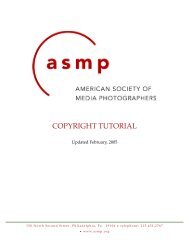
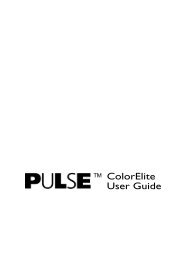

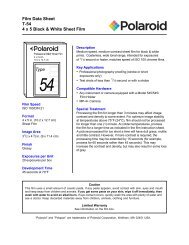
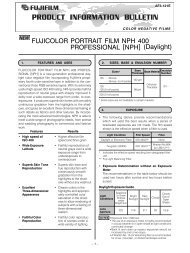
![FUJICOLOR NPH 400 PROFESSIONAL [NPH] - Fujifilm USA](https://img.yumpu.com/27607653/1/190x253/fujicolor-nph-400-professional-nph-fujifilm-usa.jpg?quality=85)
